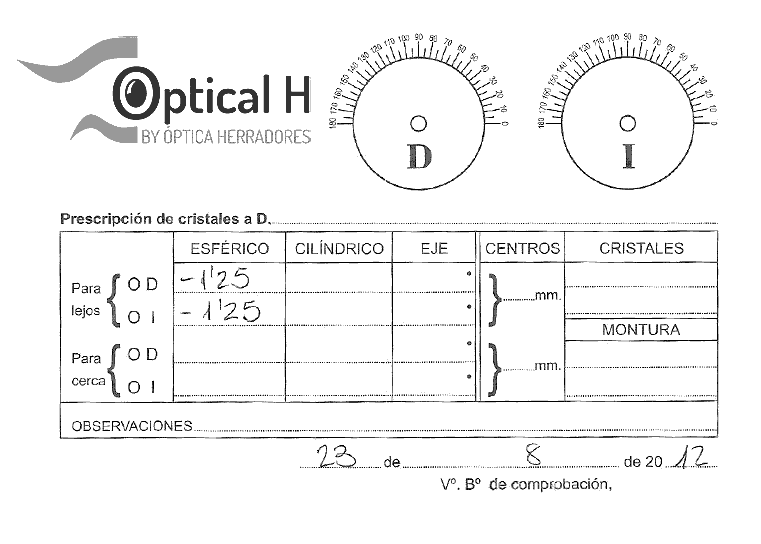Far Sphere (V.L.) or Spherical Value for Far/Distance
The spherical power indicates what type of glasses you need to correct your vision problem. It takes a negative value when correcting a myopic case and positive whether it is for farsightedness or presbyopia. Glasses that are used for reading have positive numbers. If the number is unsigned, it is considered positive.
It may appear on your lens prescription as Sph. V.L., esf., S or sph. If you are not sure of the value of the sphere, contact us and we will help you.
Cylinder
The value of the cylinder indicates the power lens required to correct corneal astigmatism (it measures the astigmatism in diopters). Astigmatism is a visual defect in the cornea, usually spherical, it appears to have a more oval shape than normal, creating two focus points on the retina. This may provoke blurred vision, headaches, etc.
This parameter can take positive or negative values. It may appear on your lens prescription as or Cil or Cyl. If you are not sure of the value of the cylinder, contact us and we will help you.
Axis
This value indicates how the glasses should be adjusted to compensate the irregularity existing in the cornea; it indicates exactly in which part of the eye you can find the astigmatism. It comes expressed in degrees, between 0° and 180°, always positive.
It may appear on your prescription glasses like Axis, a. or axi. If you are not sure of the axis value, contact us and we will help you.
Near Sphere (V.P) or Spherical Value for Close
This value indicates the power for the bottom part of the lenses. It is used in progressive lenses and reading glasses. These glasses are used mainly for reading, sewing or similar activities.
It may appear on your prescription lenses such as Sph. V.P. or simply as esf. or spherical value in the section of "For close"/ "For near". If you are not sure of the value of the sphere, contact us and we will help you.
Addition
It is the sufficient power of a lens to correct myopia, which is closely related to the spherical value (VL).
It may appear on your lens prescription as Add., A. or Ad., and it is usually the same for both eyes. If you are not sure of the value of your addition, contact us and we will help you.
Radio or Base Curve
This value indicates the curve of a lens. It depends on the shape of each eye and the larger the radius is, the greater the curvature will be.
If you are not sure of the value of the radius, contact us and we will help you.
Diameter
Is the diameter of the contact lens, its size. This magnitude determines the comfort when using lenses and it usually takes a value between 10 and 15 mm. Soft contact lenses usually have a larger diameter.
Ocular dominance
Handit is the unconscious inclination to prefer the use of one eye to another for certain purposes, such as pointing a rifle or looking through a telescope. Approximately two thirds of the population has a dominant right eye, one third have dominance on the left and a small proportion has no dominant eye.
To find your dominant eye, make a circle joining joining your thumb with the index finger. Then, set a goal such as a door handle and center it in the circle. Now, without moving your hand, leave only one eye open and then switch to the other eye. Your dominant eye is the one that is open when the target appears more in the center.
If you are not sure of what is your dominant eye, contact us and we will help you.
Pupillary Distance
It is the distance between the center of the pupil of each eye and the center of the nasal arc. It may appear as PD, DNP, IPD, center distances... It is expressed in millimeters and is usually between 25 and 40mm for each eye. Sometimes it specifies the value of the total pupil distance, of the two pupils, usually in between 50 and 80 mm.


